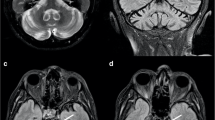Abstract
Balloon cells are histopathological hallmarks of various cortical malformations, i.e., focal cortical dysplasia (Taylor’s type, FCD IIb), hemimegalencephaly (HME) or cortical tubers (tuberous sclerosis, TSC). Whether this intriguing cell type results from similar pathogenetic pathways remains to be shown. Here, we analyzed the immunohistochemical distribution pattern of the CD34 epitope in surgical specimens from 34 patients with FCD IIb, compared to that of 6 patients with TSC and 3 patients with HME. In normal brain, CD34 occurs only transiently during neurulation, but cannot be detected in mature neuroectodermal cell progenies. In contrast, 58% of our patients showed CD34 immunoreactivity within a subpopulation of balloon cells. Interestingly, CD34-positive balloon cells were confined to the white matter, but never observed in neocortical layers. Furthermore, balloon cells expressing neurofilament protein were also restricted to white matter, whereas GFAP-positive balloon cells were observed either in white or gray matter location. Clinical characteristics did not significantly differ between patients with CD34-positive versus CD34-negative lesions. No significant correlation was found between CD34 expression and genetic alterations of the TSC1 gene, which is affected in many FCD and TSC patients and which plays a role in the regulation of cell size. Further studies are warranted to clarify the restricted expression of CD34 in balloon cells of the white matter.



Similar content being viewed by others
References
Barkovich AJ, Kuzniecky RI, Jackson GD, Guerrini R, Dobyns WB (2001) Classification system for malformations of cortical development: update 2001. Neurology 57:2168–2178
Becker AJ, Urbach H, Scheffler B, Baden T, Normann S, Lahl R, Pannek HW, Tuxhorn I, Elger CE, Schramm J, Wiestler OD, Blümcke I (2002) Focal cortical dysplasia of Taylor’s balloon cell type: mutational analysis of the TSC1 gene indicates a pathogenic relationship to tuberous sclerosis. Ann Neurol 52:29–37
Blümcke I, Wiestler OD (2002) Gangliogliomas: an intriguing tumor entity associated with focal epilepsies. J Neuropathol Exp Neurol 61:575–584
Blümcke I, Giencke K, Wardelmann E, Beyenburg S, Kral T, Sarioglu N, Pietsch T, Wolf HK, Schramm J, Elger CE, Wiestler OD (1999) The CD34 epitope is expressed in neoplastic and malformative lesions associated with chronic, focal epilepsies. Acta Neuropathol:481–490
Blümcke I, Löbach M, Wolf HK, Wiestler OD (1999) Evidence for developmental precursor lesions in epilepsy-associated glioneuronal tumors. Microsc Res Tech 46:53–58
Crino BC, Miyata H, Vinters HV (2002) Neurodevelopmental disorders as a cause of seizures: neuropathologic, genetic and mechanistic considerations. Brain Pathol 12:212–233
Healy L, May G, Gale K, Grosveld F, Greaves M, Enver T (1995) The stem cell antigen CD34 functions as a regulator of hemopoietic cell adhesion. Proc Natl Acad Sci USA 92:12240–12244
Lin G, Finger E, Gutierrez Ramos JC (1995) Expression of CD34 in endothelial cells, hematopoietic progenitors and nervous cells in fetal and adult mouse tissues. Eur J Immunol 25:1508–1516
Meencke HJ, Veith G (1999) The relevance of slight migrational disturbances (microdysgenesis) to the etiology of the epilepsies. Adv Neurol 79:123–131
Mischel P, Nguyen L, Vinters H (1995) Cerebral cortical dysplasia associated with pediatric epilepsy. Review of neuropathologic features and proposed grading system. J Neuropathol Exp Neurol 54:137–153
Natkunam Y, Rouse RV, Zhu S, Fisher C, De Rijn M van (2000) Immunoblot analysis of CD34 expression in histologically diverse neoplasms. Am J Pathol 156:21–27
Palmini A, Najm I, Avanzini G, Babb T, Guerrini R, Foldvary-Schaefer N, Jackson G, Lüders HO, Prayson R, Spreafico R, Vinters HV (2004) Terminology and classification of the cortical dysplasias. Neurology 62:S2–S8
Raymond AA, Fish DR, Sisodiya SM, Alsanjari N, Stevens JM, Shorvon SD (1995) Abnormalities of gyration, heterotopias, tuberous sclerosis, focal cortical dysplasia, microdysgenesis, dysembryoplastic neuroepithelial tumour and dysgenesis of the archicortex in epilepsy. Clinical, EEG and neuroimaging features in 100 adult patients. Brain 118:629–660
Reifenberger G, Weber T, Weber RG, Wolter M, Brandis A, Kuchelmeister K, Pilz P, Reusche E, Lichter P, Wiestler OD (1999) Chordoid glioma of the third ventricle: immunohistochemical and molecular genetic characterization of a novel tumor entity. Brain Pathol 9:617–626
Reifenberger G, Kaulich K, Wiestler OD, Blümcke I (2003) Expression of the CD34 antigen in pleomorphic xanthoastrocytomas. Acta Neuropathol 105:358–364
Scott MA, Gordon MY (1995) In search of the haemopoietic stem cell. Br J Haematol 90:738–743
Sutherland DR, Stewart AK, Keating A (1993) CD34 antigen: molecular features and potential clinical applications. Stem Cells 3:50–57
Tassi L, Colombo N, Garbelli R, Francione S, Lo Russo G, Mai R, Cardinale F, Cossu M, Ferrario A, Galli C, Bramerio M, Citterio A, Spreafico R (2002) Focal cortical dysplasia: neuropathological subtypes, EEG, neuroimaging and surgical outcome. Brain 125:1719–1732
Taylor DC, Falconer MA, Bruton CJ, Corsellis JA (1971) Focal dysplasia of the cerebral cortex in epilepsy. J Neurol Neurosurg Psychiatry 34:369–387
Urbach H, Scheffler B, Heinrichsmeier T, Oertzen J von, Kral T, Wellmer J, Schramm J, Wiestler OD, Blümcke I (2002) Focal cortical dysplasia of Taylor’s balloon cell type: a clinicopathological entity with characteristic neuroimaging and histopathological features, and favorable postsurgical outcome. Epilepsia 43:33–40
Van de Rijn M, Lombard CM, Rouse RV (1994) Expression of CD34 by solitary fibrous tumors of the pleura, mediastinum, and lung. Am J Surg Pathol 18:814–820
Vinters HV, Park SH, Johnson MW, Mischel PS, Catania M, Kerfoot C (1999) Cortical dysplasia, genetic abnormalities and neurocutaneous syndroms. Dev Neurosci 21:248–259
Author information
Authors and Affiliations
Corresponding author
Rights and permissions
About this article
Cite this article
Fauser, S., Becker, A., Schulze-Bonhage, A. et al. CD34-immunoreactive balloon cells in cortical malformations. Acta Neuropathol 108, 272–278 (2004). https://doi.org/10.1007/s00401-004-0889-0
Received:
Revised:
Accepted:
Published:
Issue Date:
DOI: https://doi.org/10.1007/s00401-004-0889-0




